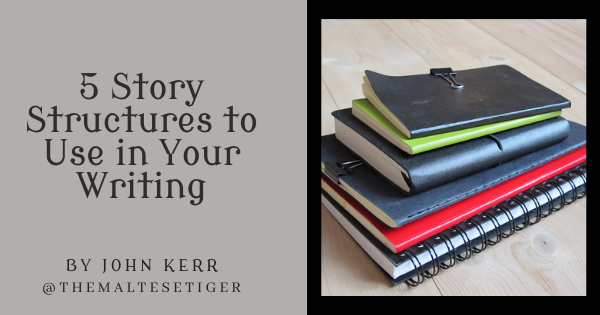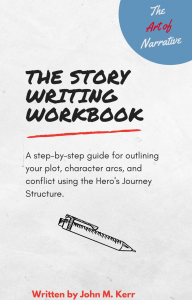by John Kerr, @themaltesetiger
Let’s talk about regrets. We all have them, right? For me, it was not realizing how important structure was to my writing life. I used to start stories or essays at random. Sometimes I’d type them out on my phone, sometimes I’d grab my laptop. I would save every document in a different place. Sometimes I’d write in the morning, sometimes I would write at night.
Do you know what that got me?
A bunch of unfinished writing projects!
But then I found a structure- get up every day at 5 am, write and edit for one to two hours, have specific daily goals, then go to work. That structure is what grew my blog, the Art of Narrative, from a few hundred monthly visitors to a few thousand. And, trust me, a good structure will transform your writing life as well. You just have to find one!
But, structure isn’t just about finding time to write. A helpful story structure can unlock the mysteries of story-telling. Structures get you from a vague story idea to a completed narrative with engaging characters and an exciting plot.
Rather than creating cookie-cutter narratives, story structure will give you the freedom to be creative. A story structure will guide the decisions you make about your plot, characters, and theme. And, a good structure will unleash your creative potential!
Lucky for all of us, there are plenty of story structures to choose from! So, let’s talk about five structures you can use to write your next story!
The Hero’s Journey
If you’re just starting out on your writer’s journey, then the hero’s journey is probably your best option when it comes to story structure.
Why do I say that? Because the hero’s journey is one of the more detailed structures out there. That’s why most Hollywood blockbusters follow the hero’s journey structure pretty closely. The hero’s journey is a well-worn and successful story design.
Your tale will have an engaging plot and a solid character arc for your protagonist by following the hero’s journey. That’s why I used this structure when I wrote my book, The Story Writing Workbook, designed to help beginning writers complete their first story!
Let’s break down the hero’s journey a bit. I’m not going to talk about the entire structure because it’s twelve stages, and that’s a whole article on its own. I have a blog post covering the journey in full if you’re interested over at the artofnarrative.com. But, here’s a quick rundown:
hero is presented in their everyday world ➡ inciting event calls the hero to act ➡ hero is fearful and refuses to act ➡ hero meets mentor ➡ hero leaves home ➡ hero is tested/ makes friends & enemies ➡ hero makes plans ➡ plans fail/ hero loses something important ➡ hero gains something valuable ➡ her recovers from loss ➡ hero sacrifices/ triumphs ➡ hero returns home victorious
Obviously, there’s a lot more to it than that. In fact, In my workbook, I spend an entire chapter on each stage. But, as great as the hero’s journey is, it’s not the only way to tell a story. There are even genre-specific structures like the one we’ll talk about next.
Monster in a House
Screenwriter, and author of Save the Cat, Blake Snyder, coined the phrase Monster in the House to describe a typical structure of many horror films and stories. This structure is broken down into three essential points.
- A monster: a character that is evil and possesses other-worldly strength or power.
- The House: an enclosed space that traps the characters with the beast.
- A sin: an action by one or more characters that brought the Monster into the House.
Now, let’s look at a practical example of the Monster in the House structure through the lens of the 1979 classic horror film, Alien.
The Monster- a ferocious and bloodthirsty alien, born on a mysterious planet.
The House- the Nostromo, a commercial space vessel and her seven-member crew on a deep-space journey, far from Earth.
The Sin- Ash, a secret android, programmed by the Corporate owners of the Nostromo to bring the alien back to Earth.
The Monster in the House is a beautiful structure if your goal is to build tension, convey a theme, and scare the pants off your reader.
Cinderella Story
This is just one of several structures made famous by author Kurt Vonnegut. The Cinderella Story is one of eight structures that Vonnegut called the “shapes of stories.” If you’d like to learn about all eight, here is a clip of Vonnegut describing each of them. But, we’ll only discuss this one because Vonnegut described the Cinderella story as the most popular story shape in Western culture.
Here’s how the Cinderella Story operates according to Vonnegut:
(By the way, you probably already guessed this structure is based on the classic fairy tale of the same name.)
The character starts at their lowest possible point. Something terrible has happened to them that they’ve never recovered from.
Ex. Cinderella suffers her mother’s death, and her father marries a terrible woman with three equally awful daughters.
The character experiences incremental good fortune that lifts them from their low station.
Ex. Cinderella meets a fairy godmother who gives her a dress, makeup, and a carriage to travel to the royal ball. At the ball, she dances with the handsome prince.
The character loses all of that good fortune in a single moment and drops to almost their lowest point.
Ex. The clock strikes midnight, and the fairy godmother’s magic disappears. Cinderella returns to her every day, terrible, life but she’ll remember the night of the ball forever.
The character regains all of their good fortune and lives happily ever after.
Ex. The prince finds Cinderella, the glass slipper fits, and they are married.
That might be the most popular story structure in Western culture, but let’s talk about a form from Eastern culture.
The Four-Act Story
The Four-Act structure is usually described as originating in Japan or Korea. Although the structure’s history stretches far into the past, it is used to this day in many manga and anime stories.
Now, as a person who has lived in the U.S. their entire life, I can’t completely describe the four-act structure to you. The truth is, I lack the cultural context needed to be considered an expert. I will break down the four parts of this structure, but please watch this video to better understand the four-part story structure.
The 4 Part Structure
Step 1: set up your story
Step 2: expand on your premise and develop characters
Step 3: introduce a twist that completely upends your premise
Step 4: conclude your story; resolution and conflict aren’t required though
Dramatic Structure
This is the one we all learned about in school. The dramatic structure breaks down into five acts; think of any Shakespeare play you read in high school. Here are the five acts of dramatic structure:
Exposition: this is setup, where the audience gets to know characters, settings, and a hint of the coming conflict.
Rising Action: the story starts to pick up here. Characters encounter conflicts that slowly increase the tension of the story and lead to the climax.
Climax: the story’s turning point and the highest point of tension in the narrative.
Denouement: closes all its arcs, and the conflict is resolved.
Those are just a few of the countless story structures that are out there for the budding writer to use. I encourage you to find the structure that fits your style and one that you are comfortable using.
Or, if you’re brave enough, you can write with no structure at all! That’s totally fine. What’s most important is that you sit down and write just about every freaking day!
Good luck with your next story!
About the author:
Hi! I’m John Kerr, and I’m a writer and a teacher. You can find most of my work over at my blog, The Art of Narrative, where I write instructional posts on fiction, poetry, and non-fiction prose. Recently I launched my first ebook, The Story Writing Workbook. The Story Writing Workbook is a step-by-step guide designed to help writers craft their stories.
You can follow me on Twitter @themaltesetiger,
Or sign up for my newsletter, and get a free chapter download of my workbook!
I’ve also just launched the Art of Narrative Podcast, and I would love for you to check it out!
5 Story Structures to Use in Your Writing (by @themaltesetiger ): Share on X
Photo credit: Risager on VisualHunt


Thanks for the post, John! Just reviewing the different story structures has kickstarted my imagination. :)
Thank you for the opportunity to guest blog, Elizabeth! I had a lot of fun writing this post. Story is one of those things I can really nerd-out over!
I like being reminded of those basic structures. They really can help give a story some direction and focus. Sometimes simply changing a structure when it isn’t working can be just what a story needs, too. Thanks for the reminder!
As we’ve seen with most anime or Oriental stories, they don’t have to have a happy ending either.
Nice to see the structures broken down into the basic steps.
Hi Elizabeth – it’s great to read and see this post … which I’m sure must be of great value to many. I’d love to write a book one day, so always useful to have these posts and references to look at. Stay safe and thank you John for these approaches. All the best to you both – Hilary
Hope you stay safe too, Hilary! Thanks so much for dropping by.